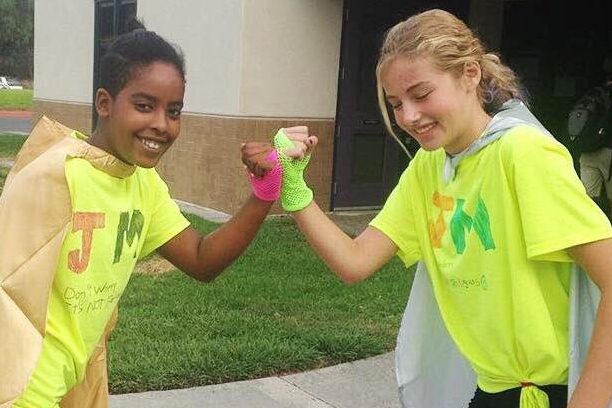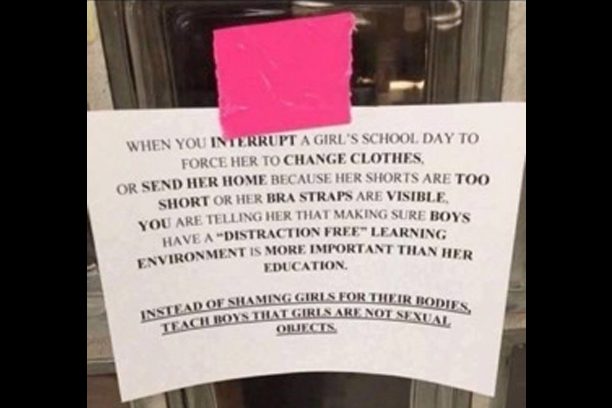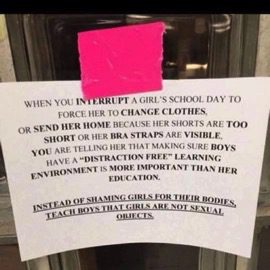
by admin | Nov 4, 2016 | Blog
A week before Halloween talk turned to costumes. My son wanted to be Darth Vader. My daughter, Casey, and her friend, Yasmin, were going to be Juslims. Casey is Jewish and Yasmin is Muslim. They combined their religions to create a tutu and stripy-tight wearing superhero. Their superpower? Watching each other’s backs. Sweet, I thought and my husband took the girls to the store to buy matching t-shirts and a cape. And that was that.
Except it wasn’t.
On the Friday before Halloween the girls wore their costumes to school. A friend snapped a picture of the superhero duo. Later that day my husband and I posted the picture up on social media. Then it happened. It went viral beyond anything I’ve seen go viral. We watched the retweets and likes go up and up and up. First tens of thousands of people responded. Then hundreds of thousands of people. Someone in England’s Parliament tweeted about the picture and so did J.K. Rowling. People from Egypt, Ireland, Israel, Pakistan, Canada and Argentina tweeted it. Buzzfeed called and then the BBC and CNN and Upworthy. Teen Vogue featured the girls and so did ABC news in Los Angeles. The next day the Juslims were even on the homepage of Yahoo.
The number of people posting about the Juslims was incredible. But the comments were what really struck me. People wrote about having their faith in humanity restored. Some said the girls should run for president. Many people tweeted some version of, “I was feeling low but the Juslims gave me hope.” People tweeted to Marvel and DC Comics to make the Juslims into a book. And yet another person on twitter created a superhero cartoon of the girls in their costumes.

My husband and I are beyond blown away that the sight of a Jewish girl and her Muslim friend in 2016 in America could affect so many people so deeply. It all felt strange and I started to feel a bit like a fraud. The girls weren’t trying to make a statement. They weren’t standing up for anyone’s rights. They were just two friends who weren’t encumbered by differences in race or religion.

Casey and Yasmin being interviewed by Buzzfeed.
Days have passed since the picture went viral. There have been various people contacting us to see if the girls want to write a book or speak at a synagogue or perhaps do another interview. I’ve asked Casey if she is interested in moving forward with the Juslims. But she isn’t. Her costume was born out of a friendship that was thoughtless, meaning race and religion never came into play. Since there was no hidden message Casey can’t really see how she could authentically continue to promote cross-racial or religious understanding. She doesn’t even think about it. That is the most beautiful part of the Juslims.
Casey and Yasmin see that Casey is white and Yasmin is black. They know that Casey is Jewish and Yasmin is Muslim. Casey knows about Ramadan, and Yasmin attended Casey’s Bat Mitzvah earlier this year. They clearly see the differences. They just don’t care. And that is truly the best part of the Juslims. It was just two girls who didn’t think about their differences in any deep or meaningful way. They are different. So what. They are way more alike than different anyway.
Raising children to be colorblind was a misguided parenting philosophy of the past. Studies show that even infants see differences in color. When children are raised to see color but value those differences instead of creating biased prejudices you get the Juslims, two girls in tutus and stripy tights who’ve got each other’s backs.
I have realized from the great response to the Juslims that there are too many places where people are left feeling different and unsupported (or worse, persecuted and unsafe). I hope that the Juslims inspire people to bravely reach out to others. Invite people who look different over for dinner or a play date. Bring people of different faiths to your mosque or temple or church. Whatever efforts we collectively around the world are doing are woefully inadequate. As one person put it on Twitter, let’s hope that the values behind the viral picture of the Juslims become as viral as the post. I’ll second that.

by admin | Oct 27, 2016 | Blog
Parents and infants should room together for one year after birth to reduce the risk of Sudden Infant Death Syndrome (SIDS). That’s the latest recommendation of the American Academy of Pediatrics (AAP)–and it’s completely unreasonable.
When I first heard the news I felt irate and grave concern. For me, personally, the idea of sleeping for up to a year in the same room as my children when they were infants was downright frightening. As a light sleeper I know room sharing would mean that I would likely go 365 days sans solid rest. But as a family coach I know room sharing could have long-term negative unintended consequences that are not addressed in the recommendation.
Parents are subjected to a slew of suggestions on childrearing from experts. Breast is best. Cover outlets. Don’t leave infants unattended in the bath or on the changing table. Properly fasten children in car seats on all car trips. Avoid choking hazards. Address chipping paint and potential lead poisoning threats. Secure windows to avoid accidental falling. Cover fireplaces and guard stoves to prevent burning. The list of health and safety advice for new parents is long and frequently overwhelming. Based on solid research, these recommendations aim to prevent harm and improve health and wellness in children. That’s all well and good. But what happens when the side effects of solid advice are potentially worse than not following the advice?
Studies show that the risk of SIDS is reduced 50 percent if children and parents share a room. However, what goes unsaid is that sleeping in the same room has its own drastic consequences. Parents and infants who sleep in the same room both experience worse sleep than if they slept alone. Think about it. If a baby makes even the softest sound the parent might assume the child is waking and preemptively feed a bottle or pick up to soothe. But if left alone the child may well have just made some noise and gone back to sleep. Research shows that children have a higher incidence of night waking when they sleep with their parents. Furthermore, mothers who share a room with children report a more strained co-parenting relationship and higher depression symptoms. Additionally, women with a history of depression reported less attachment to their children even at six months of age when sharing a room. Also, chronically tired adults and children regularly suffer behavioral affects, including diminished patience, lower coping and impaired judgement.
According to AAP, each year nearly 3,500 infants die of sleep-related causes– including ill-defined deaths and accidental suffocation. In 2014, the last year for which data is compiled, approximately 1,500 infants died specifically from SIDS. The numbers of SIDS deaths have declined sharply in the last 25 years due to an impressive education campaign. Doctors and literature all recommend that children are put to bed on their backs and without blankets and bumpers to avoid accidental suffocation.
The death of any child is heartbreaking. But one that is preventable is unequivocally unbearable. Therefore, it is logical that conscientious parents would do just about anything to prevent premature death. However, the latest guidelines cannot be considered in a vacuum. Preventing the death of 1,000 children yearly is vital. But what if the current guidelines potentially negatively affect parents of the nearly 4 million babies born every year in the United States? The collateral damage of the recommendation for the vast majority of parents must also be contemplated.
Thinking about parenting guidelines and collateral damage reminds me of my struggles to breastfeed after the birth of my first child. The clear recommendation for myriad reasons is for mothers to breastfeed for as long as possible. After my daughter had a brief stint in the NICU and I had major milk overproduction issue, I struggled tremendously to breastfeed. The pain of infection and physical exhaustion was damaging my relationship with my daughter. I didn’t even want to pick her up for fear of producing more milk or feeling pain. After the third distressed call to my doctor she uttered words that went against popular medical advice–”Maybe you should stop breastfeeding.” She didn’t want to discourage me, but she sensed what I knew all along. Breastfeeding, while highly recommended, wasn’t the only important aspect to consider when deciding what was best for my child. Our relationship was paramount and breastfeeding was impairing that relationship.
While I respect the AAP and use their recommendations on a variety of parenting matters, I do think a conversation needs to be started about how to interpret their guidelines. Parents need to be educated and supported to make choices that are right for their family considering the evidence presented. All of the evidence. Not just the narrow focus of one particular recommendation.
Preventing SIDS is immensely important. No parent should have to experience that loss. However, the AAP recommendation of room sharing should be interpreted as a guideline. In no way do I recommend putting children to bed on their stomachs or co=sleeping in the family bed. Those risks are considerably higher. But the benefit of room sharing just doesn’t seem to outweigh the relative risks.

by admin | Aug 29, 2016 | Uncategorized

On the middle school website the stated purpose “for student dress and grooming standards is to foster an educational environment.” Except at back to school night I heard a different story from the gym teacher. The presentation started out predictably dull. The kids were slated for hockey (wow!) and football (ooh!) and soccer (fantastic!) and, oh, the female gym teacher almost forgot to mention–girls were not permitted to wear yoga pants or leggings, because it might cause the boys to spring an erection.
Whoa. What?
Yes, you read that correctly. My daughter, barely 13, cannot wear yoga pants or leggings in gym, because some kid might be aroused. The teacher elaborated. She said boys this age had a difficult time controlling themselves. They could be stirred by the sight of a girl in exercise pants in exercise class. The resulting erection could be embarrassing. Hence, in order to prevent this type of humiliation for the boys the gym teacher required the girls put shorts over their exercise pants.
It all happened so fast. Did I actually hear the teacher correctly? After class I went back to speak with her again. She clarified. Well, she tried to clarify, as one tries to dig her way from a pile of quicksand. She told me one of the reasons this is an issue is because she requires the students to tuck in their shirts, you know, to be respectful. She believes when the girls have their shirts tucked in, wearing yoga pants, it’s just too revealing for the boys. Got it?
Um, no. I do not. In fact, I am horrified.
In the 1960s and ’70s, the girls all wore miniskirts that barely covered their rears, and the boys still managed to graduate. Walk on to any college campus today and one spots students wearing yoga pants, sweatpants and even pajamas to class. Somehow an educational environment is still maintained. The male students find a way to suppress any possible sexual feelings while in the classroom because it would be inappropriate otherwise.
Yet middle and high school dress codes are popping up with reckless abandon around the country. Girls can’t wear tank tops or spaghetti straps on dresses. Skirts need to be no shorter than fingertip length. Just fire off a quick Google search, and you’ll be startled by the number of schools limiting what girls–but often not boys–can wear. It’s happening in Kentucky. It’s in Texas. And in Indiana. And in Oregon. The girls in New Jersey were so fed up with the insinuation that they are a disruption they created the Twitter hashtag #Iammorethanadistraction.
Why is there a sudden problem with clothing being so terribly distracting in school?
The objectification of a woman’s body is pervasive in our culture. I don’t know of a single woman who hasn’t experienced cat calling, unwanted whistling, fear of being followed, sexual harassment or sexual assault. A national poll conducted by The Washington Post and Kaiser Family Foundation in 2015 reported that 25 percent of women attending college experienced unwanted sexual incidents. The problem isn’t that we aren’t creating an educational environment in school. It’s that we aren’t teaching boys and young men that women are not sexual beings first and foremost.
Banning yoga pants for the purpose of avoiding unwanted erections sends the message that boys are programmed to respond and can’t help what their bodies do. Boys and men are responsible for their actions. It’s no wonder some don’t stop unwanted sexual advances when they hear a woman saying, “No.” Short skirts and leggings don’t cause sexual advances–the inability to manage one’s desires does.
Instead of draconian dress codes what we really need are conduct codes. Enough with stifling the girls to help the boys control themselves. That’s demeaning to the boys as much as it is to the girls. Why not state the expectation that on school grounds any sexual activity or expression will not be tolerated. Children can learn to control themselves when there are clear expectations for how to behave with consequences for misconduct.
It isn’t the responsibility of my daughter (or any daughter) to help boys manage sexual urges. It is the responsibility of the boys. It isn’t OK to start shaming girls about their bodies by telling them to obsessively cover up. And girls should not have to disregard their own comfort to protect the comfort of the boys around them.
I came home from back-to-school night and discussed the gym teacher’s remarks with a male friend. He thought I shouldn’t have told my daughter the reason she couldn’t wear yoga pants. I disagree, strongly. Girls need women to break down these issues when they are young, before they are shamed or harassed or raped. It’s one step closer to showing girls that wearing a short skirt isn’t akin to asking for “it”. I need to show my daughter what saying no looks like. And I need to help change this policy so she can see what change looks like.
Shielding my daughter from the realities of being a woman will not help her stay safe in any environment, educational or otherwise. Speaking up about, in her presence, will.
…
Side Note: After speaking with the school’s assistant principal I was assured the gym teacher would be reprimanded for her inappropriate remarks, and the school is working on crafting a policy for gym clothes.


by admin | Jun 8, 2016 | Blog

I had near perfect attendance in grade school. It was annoying. My sister was sick all the time and got to have the TV put in her room while I had to run off to school. One year my mom took pity on me and surprised me with a hooky day. She said I didn’t have to go to school. Instead we could do something fun. I don’t remember at all what we did. Clearly that didn’t matter. What did matter though was that I learned that sometimes taking a day off is more important than the seemingly important stuff in our lives.
Today I learned that lesson again. I am completely swamped with work and life. My to do list has several mini lists. I can’t see the light at the end of the tunnel at all. I’m stressed and burdened and missing the fun of life worrying about what I have to get done. I’ve been on the brink of tears for several days. My kids are out of school for the summer in just one more day. Panic is setting in rapidly.
Then I get a text. I wasn’t even out of bed but I was already thinking about what I will conquer first on my last full day to work. I grab the phone and it’s my friend Noel saying, “Last minute paddle board trip, share my board?” Oh crap. I have no time for this. No business at all dropping my work to run off with a friend to paddle. Then she adds, “Cloudy, but calm.” It’s at this point that the thought of my childhood hooky day floats by. The joy. The surprise. The adventure. I wrote back, “OK, Darn it. I’m coming.”
For the last year since I moved to California I have been trying to paddle with sea lions, whales, dolphins and anything else that wants to swim by. Usually it’s windy or murky or there are gigantic waves. When I heard it was calm I couldn’t resist.
So I hopped in the car and met Noel and another friend Michelle. The ocean was like a watercolor painting. Flat, reflective, beautiful. We saw another boarder out quite a way surrounded by dolphins. Noel was determined. I sat on the front of her board and she worked like a woman on a mission to paddle us out there before the dolphins left. For a while it seemed like no matter how far we paddled they were still further away.
 We took turns paddling. Finally, both exhausted, we made it. There were dolphins and more dolphins. They just kept coming in packs. Big, stunning, shiny dolphins only 15 feet from our board. It was a thrill of a lifetime that I almost missed because I have a lot of work.
We took turns paddling. Finally, both exhausted, we made it. There were dolphins and more dolphins. They just kept coming in packs. Big, stunning, shiny dolphins only 15 feet from our board. It was a thrill of a lifetime that I almost missed because I have a lot of work.
Now I’m home and the to do list stands unattended. I haven’t made a dent. I’ll be up late tonight and I’m sure tomorrow night too. But a hooky day was exactly what my psyche needed. Now I feel ready to face the work with a smile dreaming of my dolphin friends from this morning. I’m not stressed. I’m happy.



by admin | May 5, 2016 | Blog

Waterfall at Hetch Hetchy
7 days, 983 Miles, A Castle, Elephant Seals, A Coyote, A Kringle, Beaches, Waterfalls and a National Park
A year and a half ago my family made the decision to leave all of our friends and family in New York and move out to the West Coast. I had lived all my life in New York except for the four years of college. My parents grew up in New York and my grandparents (except for one) were all born in New York. Even my great grandparents came off their boats into New York. So it was pretty radical for us to pick up and relocate. People asked us if we moved for work. But we said, “No.” Others asked if we moved to be closer to family. Same answer, “No.” We moved for a family adventure. We wanted to see different people in different lands. Now, California may not seem so different but it is. We were moving to see another part of the country and get to know it.
This year my son is in 4th grade. Thanks to a brand new initiative started by President Obama, he and my entire family get into any national park for free. Given this great opportunity and the fact that this is the centennial year for the National Park system, we decided to make spring break a road trip. For seven days we would see some of California’s state treasures, including the breathtaking Yosemite Park.
Our trip was magical. I don’t mean nothing went wrong or it was all perfect. It wasn’t. But it was an opportunity for the four of us to spend literally 24/7 together disconnected from the Internet and our electronics. We had no computers, no cell service and no WiFi. And we survived. Here is a summary of our fantastic trip with some details in case you too want to take the same trip.
Day 1 Santa Barbara, Solvang and Pismo Beach
We left Southern California and headed for Santa Barbara. My friend, Ellie, told me we had to stop at La Super Rica. She was right. It is an off-the-beaten-path gem beloved by Julia Child for homemade Mexican food with handmade tortillas created the moment they’re ordered. Among other things I had the rajas, which is grilled green chiles sautéd with onions and melted cheese. Sounds simple, but I tell you this is one of the best morsels of food I have ever had. I will dream about the rajas.
Traveling with children requires a special itinerary. In my family we set the schedule around food. My kids are happiest when they can get a special snack and visit a bookstore on vacation. The town of Solvang in Santa Barbara County was a perfect second stop on the way to Pismo Beach. It was a wee bit out of the way but totally worth it. Solvang is a Danish hamlet in the middle of nowhere. It has windmills and clogs and Dutch-looking buildings. We stopped at The Danish Village Bakery and Coffee Shop. The baked goods all looked amazing, but when I spotted the Kringle (like a Nordic pretzel stuffed with custard) I knew we had to get it. Another great choice. We had so much dessert we skipped dinner. That was a first for us. Solvang also had a fabulous independent bookstore where both kids bought a book to keep them busy for the rest of the journey.

Solvang Bakery

This is a Kringle.
We ended the day checking into the SeaCrest Oceanfront Hotel in Pismo Beach. It was late and after some initial hotel room excitement the kids went to bed for the night. Lacking electronics, I happily did, too.

View from SeaCrest Hotel Room
Day 2 Architectural Graveyard
The SeaCrest offered a mediocre breakfast. But at the meal I met a nice lady who visited the are a every year. She recommended The Architectural Graveyard at California Polytechnic State University, then Hoagies restaurant for dinner. We really didn’t have anything planned for the day so we took a trip to see Cal Poly and the graveyard. To get the graveyard one must take a 2.5 mile hike at a slight incline. The massive structures built out of steel and concrete were left there as part of a senior engineering design class at the college. In April (especially in an El Niño year) the wildflowers were rampant. After running through the flowers, a la Laura and Mary from Little House on the Prairie opener, we wandered through the structures. Some could be climbed, others were just amazing to behold. It is unlike anywhere I have been and probably one of my favorite portions of our trip.
a every year. She recommended The Architectural Graveyard at California Polytechnic State University, then Hoagies restaurant for dinner. We really didn’t have anything planned for the day so we took a trip to see Cal Poly and the graveyard. To get the graveyard one must take a 2.5 mile hike at a slight incline. The massive structures built out of steel and concrete were left there as part of a senior engineering design class at the college. In April (especially in an El Niño year) the wildflowers were rampant. After running through the flowers, a la Laura and Mary from Little House on the Prairie opener, we wandered through the structures. Some could be climbed, others were just amazing to behold. It is unlike anywhere I have been and probably one of my favorite portions of our trip.


After a quick lunch we headed to the Morro Bay Estuary (where a river meets the sea) for a little bird watching. This place is an absolute gem. My son took out his California bird guide, and we went hunting for birds. Turns out that area is a rookery (breeding colony on the tops of trees) for Herons and Cormorants, both of which we saw nesting. We headed onto Morro Bay Main street for a quick bowl of clam chowder, and then we were off to find the otters. Morro Bay is home to loads of otters that hang out in the kelp just off Morro Rock. The sunset was breathtaking as we made our way back to Pismo beach so we pulled over to watch the show. The kids weren’t feeling it so they relaxed in the car as we gazed over the water. All tuckered out at nearly sundown we rolled into Hoagies for a great low-key, family-friendly dinner before we all collapsed in our beds.

Morro Bay Estuary
Day 3 Elephant Seals and Hearst Castle
For day three we scheduled a visit to Hearst Castle. But before we left Pismo beach we stopped at Old West Cinnamon Rolls for their famous, well, cinnamon rolls. Sure, they are a bit sweet and excessive for breakfast but we were on vacation. On the way to the castle we stopped suddenly because we saw zebras on the side of the road.

With the zebra
Yup, zebras. Apparently they are descendants from William Randolph Hearst’s collection of wild animals. Then we stopped to see the Elephant Seals at the Piedras Blancas rookery in San Simeon. The beach was so covered with seals that my son didn’t even notice them at first. They lounge and throw sand and somehow get in and out of the water. We could have watched them for hours.

Elephant Seals
Finally we parked at the bottom of the hill from Hearst Castle and waited for our tour to begin. It is necessary to buy one of the tours to see the castle. Make sure to book in advance because they sell out and you don’t want to get all the way there just to see the parking lot. The castle is beyond extravagant. Our guide was a bit wordy and loved to tell a winding story, but he was also incredibly knowledgeable. I left the castle feeling like a dreamer. It’s just that kind of place.
After an eventful day we hopped back in the car and headed toward The Oaks Hotel in Paso Robles. The drive was spectacular, with rolling green hills and the most amazing cows. Were I to be a cow, I’d want to live somewhere between the coast at San Simeon and Paso Robles. Cows have acres of pasture to eat and roam as they please. I probably stopped 1,000 times to talk to the cows and take pictures. I love those cows.
The Oaks in Paso Robles looks like a La Quinta from the outside. Ordinary. But then you step into a hotel that is cared for like a beloved bed and breakfast. When I booked the room I asked for them to leave the kids a surprise by the bed. It didn’t matter what it was. My kids love hotel rooms and all the mysteries waiting behind an unfamiliar door (free soap! Conditioner!). Anyhow, this time the hotel staff left a basket chock full of goodies. The breakfast was extensive and included any kind of eggs you wanted made on demand by the chef.
Day 4 Mariposa and The Gold Rush
Right after breakfast we embarked on our three-hour drive through wine country and farms to Mariposa. Mariposa, California is a sleepy town founded as an outpost for gold miners. It doesn’t look like much has changed in the town, in a good way. The kids were ready for a treat so we stopped at Jantz Café and Bakery in the village. My daughter got the behemoth and delectable coconut cream pie with real meringue that tasted like marshmallow clouds. The crust was light and buttery and insanely fresh. I had a fruit pocket (think Pop Tart) made form the same piecrust. They were so delicious we stopped back at the bakery on our way out of town the following day for four more pockets.

Chilling at The Restful Nest
We spent the night at the Restful Nest Bed and Breakfast.
I’ve stayed in many B&Bs across the country. I have never had a better breakfast or one that was prepared by someone more thoughtful than owners, Lois and Jon. Breakfast consisted of two types of homemade sausage, stuffed mushrooms, thick cut bacon, muffins, several types of eggs, fruit plates, a Spanish tortilla with potatoes, cut vegetables with homemade hummus, and assorted other goodies. Lois and Jon made sure that every food allergy and preference was accounted for. They are lovely people. The room wasn’t fancy and the furniture has probably been around a while, but it was spotless. We were all sad to leave so soon.

Breakfast Feast
Day 5 Welcome to Yosemite National Park

El CapÃtan and Half Dome with Waterfall
We had a great trip so far but I couldn’t wait to get to Yosemite National Park. We drove into the park from the west on route 140. The rock formations were imposing and majestic. The wildflowers blanketed the hillside with orange splendor. It was so magnificent it all looked a bit manufactured, like a grand movie set. We made our way east and then north in the park toward Hetch Hetchy, a reservoir formed on the Tuolumne River. This is an out-of-the-way area in Yosemite and many of the roads and trails in the park were still closed due to the winter snowfall. This made it feel like we had the park to ourselves. We parked and walked across the dam, through a long dark tunnel and onto the trail that followed the rim of the giant lake.

Hetch Hetchy
The park ranger told us to hike until we saw the second waterfall. This would be about five-mile walk round trip. It was a warm, sunny day and my daughter was dragging a bit. But then we made it to the second waterfall and the magic happened. The kids decided to slide down the rocks and into the mini pools of water. I happily watched as the plunged into freezing cold-yet-invigorating water.
Feeling refreshed we walked back to the car and drove the short distance to The Evergreen Lodge. The lodge reminds me of the hotel in Dirty Dancing, just a good old-fashioned family vacation spot. They have activities throughout the property including billiards, ping-pong, a rope zip-line swing, climbing elements, a pool and adventure games. Every night we rushed to the giant fireplace to enjoy smore’s with families from all over the country and the world. It felt oddly like being away but also being home. Full from dinner and sticky from our s’mores we turned on the gas fireplace in our room and drifted off to sleep.
Day 6 Yosemite Valley
Behind our room the woods was home to birds and animals galore. We awoke to find families of deer roaming and gorgeous Steller’s Jay birds. On the way to the valley we stopped to hike down to the Giant Sequoias in Tuolumne Grove. It is a 3-mile hike down and then through the forest. The hike back up is a little challenging but we managed. The trees are like statues or monuments. Massive and vulnerable, yet sturdy and strong. There is one tree you can walk through and one that has fallen and decayed so that you can tunnel through it along the ground.

Mirror Lake
We left the trees behind and headed to the Yosemite valley. Along the way we spotted El CapÃtan, Half Dome, and many wondrous waterfalls. Since the snow was still melting throughout the park there were waterfalls around every turn. One waterfall was as high as the Empire State Building. We parked at the Yosemite Village Visitor center and hopped on the bus to the trail for Mirror Lake. The hike to Mirror lake was easy and well worth the effort. The lake lived up to its name–it was as still as glass and reflected like a perfect mirror. After another long day of hiking and driving we settled back into The Evergreen for dinner, s’mores and bed.

Mirror Lake
Day 7 The Final Day
We grabbed breakfast to go out of the Evergreen convenience store and hit the road. Just wanting to enjoy one last bit of Yosemite, we left through the south entrance on Route 41.
Before leaving the park, we spotted a bushy coyote. We pulled off the road and he walked right up to the side of the car and just stood there. Time stopped, we had our moment with him, and then he wandered off.
On the way out of Mariposa County we stumbled upon Coursegold Historic Village. Walking through this unique shopping area with teensy-tiny historic buildings was like taking a walk in the 1850s. After a quick pause for coffee and Italian soda’s from Zanders, we were on the road again.
An emergency bathroom break took us off the highway into a McDonalds about 30 minutes north of Bakersfield. Before getting back on the highway we realized we were in McFarland, made famous from “McFarland, USA,” a terrific film that you should see. We drove up to the high school and they were having a giant track meet. Considering the movie is about McFarland High’s impressive running program, this was thrilling. My kids couldn’t care less, but I exited the car to snap some pictures.

McFarland, USA
The kids regularly watch “Diners, Drive-Ins and Dives,” the Food Network show. We all love to eat and travel so it’s a family classic. When we travel we always try to find a restaurant that was featured on the show to stop for a bite. We uncovered a winner with Moo Creamery in Bakersfield. The place is a little hard to find (it’s tucked in the back of a parking lot), but when one enters she steps into an updated-but-retro version of Al’s Diner from Happy Days. The food was great–especially inventive ice cream flavors like cereal milk and maple bacon.
Final Thoughts
The California coast and our National Parks are spectacular gifts from nature. Most of the best activities and sights in our itinerary were free or inexpensive and access was easy. We encountered deer, zebra, coyote, cows and more cows, elephant seals, otters and loads of amazing birds. This trip exceeded all of our expectations. 
Taking a road trip with a nearly 13-year-old daughter is supposed to be rough. Girls that age are purportedly moody, and they have trouble venturing away from their friends and (gasp) WiFi. My daughter has her moments but she was an absolute delight on this trip. Throughout our week-long adventure my daughter and I walked with her arm around my shoulders and mine around her waist. She isn’t much of a hugger and that’s just fine. But it makes these moments when she initiates putting her arm around me like camp buddies that much more special. 
We all experienced a little sadness when we returned home. It was just that good of a trip. On to planning the next adventure.

I’m the shorter one relishing the moment.

by admin | May 1, 2016 | Blog

I’m a social worker. I’m a mom. I’m a family coach. And I’m, um, maybe, a writer? I have been working on my writing for eight years. I’ve had some success and some embarrassing flubs and loads of rejections. It’s all part of the learning process. Because I’m new to the blogger scene I’ve never been to a conference. But when I saw Mom 2.0 was coming to my new hometown I decided to go to my first blogger conference. There were a few things I could learn from the bigwigs.
In the lead up to the conference I was inexplicably terrified. I’m a fairly confident person but not about my writing and not in a room filled with, oh, 700 of the best mommy bloggers in the country. So as the days grew closer my freak-out level mounted. I worried I would feel like a fraud. I convinced myself my clothes were hardly cool a decade ago. My haircut was too short and the color was turning orange. All of my insecurities were exploding.
But I’ve never been one to walk away from a challenge, so I went. And thank goodness. I didn’t simply survive Mom 2.0. I had a tremendous experience. Now that I’ve been through it, here are a few things I wish I knew before I dove in …
Everybody poops: There are some people at Mom 2.0 who are absolute superstars in their genre. They have tens of thousands or even hundreds of thousands of fans and followers. One woman I met has more than 1 million people on Pinterest following her pins. Wow! I heard so many prominent speakers say that while they have ________ (fill in the blank with an insanely high number of followers) on one social media platform, they only have 7,000 followers on Facebook or Twitter. In the world of blogging, followers are currency, and the richness of some can be shockingly overwhelming especially if you’re like me, and you’ve scratched and clawed your way to 5,000 followers. But then, just when you start feeling down, you enter the bathroom. And all those ladies who seemed superhuman five minutes ago are there. They pee and poop just like you do and you realize that, come day’s end, a person with 10 million Twitter followers is just like you: Human.
It doesn’t matter what you wear: I have slim pickings in my closet. I hate shopping and clothes never fit me (too big on top, too small on the bottom). In the weeks before the opening party, I heard people discuss their clothes and post wardrobe photos–and the private panic attack brought me back to middle school. I managed to pick out a few items that could pass as almost cool and felt at peace for two seconds. Then the weather turned windy and cold and I had to make last-minute changes. How would that go over? What would people think? Would I be an outcast? Eh, no. I wore jeans and sweaters for three days. No one gave a shit.
We all have insecurities: Blogging (and writing for that matter) is a singular activity done in the privacy of a bedroom or anonymity of a Starbucks. When we are writing we wear pajamas and our hair isn’t brushed. Most of the time there is a coffee stain or some bit of lunch on our shirts. Spending loads of time alone makes meeting up with a large group of people a wee-bit stressful. Everyone’s anxiety is raised right before Mom 2.0. Will I look good enough? Will the cool people talk to me? What if I say something stupid? Turns out everyone is nervous about something. But we are all good enough and cool enough, so we should stop worrying.
Not everyone has her best friend at Mom 2.0: Reading all of the Facebook posts it feels like everyone knows one another, and they are all the best of friends. I’m here to say that’s not true. Sure, some women are tight with bloggers and podcasters and influencers they met in past years. Yes, they can’t wait to see each other again after communicating online for a year. But there are way more who arrive flying solo and feeling like the only outsider. I met loads of friendly interesting women who were also looking to make connections because they too came alone.
If you say hello someone will say hello back. It’s that simple.
Don’t miss a meal: Chatting over a quinoa lentil salad somehow seems easier than walking up to a random person and starting a conversation. Look up from your cup of coffee every time someone new sits down and say, “Hi. Welcome to the table.” By the time you reach for your perfectly crafted Ritz-Carlton tiramisu demitasse you will have met eight new people. Now imagine meeting eight new people at every meal for two days. That’s a lot of new friends.
Wear a conversation starter: If you have a hard time meeting new people or initiating a conversation, wear an amazing necklace or color your hair pink or bump up your shoe choice. We are women, and we like to dole out compliments. Use that opportunity to open up the conversation and get to know another person.
Women at Mom 2.0 aren’t the mean girls we imagine in our heads: Somehow when a bunch of women get together we are reminded of high school. The cliques and gossip and mean comments about our weight are forever ingrained in our minds. But there is none of that at Mom 2.0. These ladies are nice. Not everyone became my new best friend but not one person was even remotely rude to me. Most of the time I felt like I was at a reunion from camp but I couldn’t remember the people.
It won’t go as planned: On the morning of the first day of the conference I woke up with my eye swelled to the size of a golf ball. Maybe something got in it the night before as the wind kicked up. Or maybe I had some disgusting infection. I had no idea. But with that gross eye issue I knew that taking professional-looking headshots was out. Doing a taping for The Today Show was probably out too. And what’s worse my already shaky confidence took a nosedive. But then I heard Soledad O’Brien speak and with the Dove #Beauty Is signs surrounding me I decided not to let my eye derail me. I put on my broken glasses and walked right up to the Today Show producer and made my pitch. I took my picture at Kia anyway (It’s frightening). In the end I relaxed, met loads of new people and even though the summit didn’t go just like I imagined, it was perfect.

Astronaut Cady Coleman and My Swollen Eye

by admin | Feb 19, 2016 | Blog

I’m Jewish but not religious. Leaning toward agnostic, but hopeful I’m wrong, I’m more like Jew-ish when it comes to following the laws of the Bible. However, I still have a strong Jewish identity. To me, being Jewish is like being West Indian or Irish. It’s more of a culture.
I went to Hebrew school to learn prayers and songs and stories of the Jewish people. I hated it. We all hated it because it was foreign and boring. I learned to read a language in words only. No one taught me what any of it meant. After 11 years of religious education the only words I knew how to translate from Hebrew into English were Sheket Bevakasha–“Quiet children.”
Even before I had kids I knew I wanted to raise them Jewish. And I knew I wanted my children to have Bar and Bat Mitzvahs. Despite my shoddy Jewish education I had a Bat Mitzvah, too. My parents had been recently divorced and I didn’t want a big party or event. So my mom made a lunch at the house for family and a couple of friends and then we took a trip to Israel. Although my Bat Mitzvah didn’t feel like an especially religious moment in my life it was deeply important to connect me forever to the Jewish people. I had to learn to really read Hebrew. I had to learn the prayers that my people had been saying before and after the Torah reading for centuries. It was my first big accomplishment.
When my daughter was six we enrolled her in Hebrew school. This was the precursor to the Bat Mitzvah. Over the years she often loved and then hated Hebrew school for all the same reasons I did. And even though I could totally relate it became non-negotiable. She would learn about her people and she would have a Bat Mitzvah.
This past weekend was the culmination of her Jewish education, her Bat Mitzvah. Since we recently moved across the country we figured we would have the ceremony in the temple and celebrate on a very small scale with just our immediate family. But it ended up being so much more than that.
Family from New York, Florida and Chicago made the trip. In attendance were first cousins and second cousins and third cousins. We had parents and grandparents and even great grandparents there. Some of our closest friends and neighbors also made it to the event. Our immediate family extended into the vast village of people who helped raise my daughter.
Every single thing for the weekend turned out perfectly. The weather held up despite the threats of an El Niño. No one got sick. The service and party went off without a hitch. Kids ran around barefoot in the sand. Girlfriends from school danced around and made silly faces for the photo booth. Adults gushed about how personal the rabbi made the service and about the cantor’s voice and about my daughter’s maturity.
 In the end none of that really matters. The most meaningful moment in the entire weekend of festivities was when my daughter read her Torah portion standing on the bema with her 96-year-old great grandmother at her side. There was something about the continuity of the ritual that hit home for me. I don’t care if my daughter continues her Jewish education. I don’t really care if she visits Israel for her birthright trip. She now knows enough to enter any synagogue from Venice to Argentina to Russia and despite a fundamental language barrier she can still participate in the service in the language of her people.
In the end none of that really matters. The most meaningful moment in the entire weekend of festivities was when my daughter read her Torah portion standing on the bema with her 96-year-old great grandmother at her side. There was something about the continuity of the ritual that hit home for me. I don’t care if my daughter continues her Jewish education. I don’t really care if she visits Israel for her birthright trip. She now knows enough to enter any synagogue from Venice to Argentina to Russia and despite a fundamental language barrier she can still participate in the service in the language of her people.
Our home will still be sort of Jew-ish. We will celebrate all the holidays and continue traditions such as having a bris or the Passover Seder but none of us is particularly religious about those rituals. We do them because our people do them. I hope my daughter learned that this weekend and it connects her to the Jewish people for the rest of her life and the lives of her children and grandchildren and great grandchildren. I can’t explain why but that’s important to me.

by admin | Jan 26, 2016 | Uncategorized

Not too long ago I received an email asking if I wanted to try out some new snacks for free. The goal of the email was for me to taste the product and write a glowing review thus providing some nice advertising for the company. I like snacks and I especially like the free kind so I signed up.
A few weeks later my snack pack arrived. Quite honestly I was prepared to dislike these chips. I am all for healthy eating but the chips were pushing it with gluten free, vegan, kosher, low fat, non-GMO and baked. How could something with all of those restrictions actually taste good?
Well, they do taste good. Not just good but delicious and so satisfying. These chips are made from peas and corn with a bit of oil and salt. They are as crunchy as Doritos with none of the guilt. The chips are also dry to the touch which is different from other pea crisps that I have had. I tasted three varieties: Original, Sriracha and Aged White Cheddar. My favorite by far is the Original. The Sriracha was too garlicky for me but some will like that. The cheddar ones were tasty too but I preferred the plain ones.
What I really like about these chips is that they are really really crunchy and really healthy. One good-sized portion has only 2.5 grams of fat, 120 calories, 4 grams of protein and 1 gram of fiber. You really can’t beat that kind of nutrition in a snack.
My kids tasted the snacks and no one was particularly moved by them. But I think they might grow on at least my son. So the bottom line is that I got the snacks for free but now I am a believer. I will have to head to Whole Foods for my next supply.
Are you wondering how you too could get free snacks? If you want to try The Real Deal Veggie Chips for free here is your chance. Send your email address to me at [email protected] and I will raffle off a package of chips. Happy snacking!


by admin | Dec 12, 2015 | Uncategorized

Photo credit: Noel Besuzzi
A few weeks ago Mark Zuckerberg, the chairman and chief executive of Facebook, made an amazing and unprecedented announcement on, of course, Facebook . It had nothing to do with the company. It was a personal post stating that he had decided to use two months of paternity leave when his daughter was born. He cited research that showed that outcomes for children and families are better when working parents took time off to be with their newborns.
Contrast Zuckerberg’s announcement with that of Yahoo CEO Marissa Mayer. Several years ago she took a mere two weeks off after the birth of her son. She just gave birth to twin girls and recently revealed on her Tumblr page that she planned to approach the pregnancy and delivery much like she did with her son by, “taking limited time away and working throughout.”
The backlash against Mayer was vicious. Some condemned her for minimizing and even trivializing the importance of maternity leave. Many wondered why she bothered to have a child if she didn’t want to spend time with it when it was born. A small dissenting few thought she was an excellent example of a woman at the top working hard at her job. But in a blog post written for the Lean In website founded by another powerful working mother, Sheryl Sandberg, Mayer explained that her brief maternity leave had little to do with her desire to be a mother or her thoughts on maternity leave. “After 13 years of really hard work at Google,” Mayer wrote, “I had been envisioning a glorious six-month maternity leave. However, if I took the new job, a long leave couldn’t happen. The responsibilities were too big, and time was of the essence–it just wouldn’t be fair to the company, the employees, the board, or the shareholders for me to be in the role, but out for an extended period of time.”
And there it was. Mayer knew that if she wanted to succeed in her high-level career she would have to sacrifice time with her children. It is unclear if Mark Zuckeberg doesn’t have the same pressure because he is a man or because he is the head of what was once his own company. Being fired isn’t a probable outcome for him whereas Mayer is in real danger of being fired as her company’s profits decline.
The issue of leave after a baby is born is a hot topic. The United States is far behind the rest of the industrialized world in providing a paid opportunity for parents to bond with their newborn child. However, focusing on the few months after the baby is born only scratches the surface of some of the issues working women face once they become mothers.
Just before Zuckerberg and Mayer’s announcements, my new book agent called to tell me she was leaving the business. I was disappointed, and I wanted to know why, a mere month after signing me, she decided to bolt. As soon as she explained, though, I understood. With a sad resignation in her voice, my agent said she needed to quit her dream career in order to spend more time taking care of her young son. She said she was 100-percent certain the decision was the right one, though she seemed plenty unsure. What if she was making a huge mistake leaving her career? What if she regretted it and ultimately wanted her job back–but only after it was too late? Would the publishing world move on without her? Proceed forward as if she never existed? She loved her son. She loved her job. She wanted … both. But knew it was impossible.
These were the same struggles I confronted during my first pregnancy 13 years ago. After my daughter was born I changed jobs several times trying to balance my need to be with my child and my career interests. At the end of my rope in my current job I ended up accepting a seasonal summer job as a social worker in a sleep-away camp for homeless children. Although only a temporary position it was the job I was meant to do.
That summer I slept at the camp every other night. On the days away from my nearly one-year-old daughter I missed her terribly. Shouldn’t I be home with her instead of taking care of someone else’s kids? What milestones was I missing for the sake of my job? It was a hard summer but I made it through and by the end I was offered the job for which I worked the previous ten years. I was hired to be the full-time camp director at another sleep-away camp for low-income children. The job came with housing, and I imagined running the camp and being a mother simultaneously. We would be one big camp family.
But it didn’t happen that way. The dream wasn’t real. Real life was that I worked 16 hours daily, and I almost never saw my daughter. One day my child had a seizure while out with the babysitter. I wasn’t there and I couldn’t leave camp to meet her in the emergency room because I was also needed at the camp. You cannot imagine the pain a mother feels when she cannot be with her sick child because of a career choice.
Another year passed and I became pregnant with my second child. Faced with the thought of raising two children with my hours I decided to leave my job and my career. It seemed there was no way to be successful at work and successful at home in equal measure. Something had to be sacrificed and I wasn’t willing to sacrifice my children. It only took three years for me to realize that being the career woman I imagined and the mother I wanted to be were incongruent. I wouldn’t run a camp for special needs children. I wouldn’t travel the world on rescue missions. And I wouldn’t be making the world a better place in my job anymore. That hurt. I was a social worker. That’s who I was and what I worked for. Who was I now if I didn’t work?
In Sheryl Sandberg’s 2010 TED talk that was the inspiration behind her bestselling book Lean In she told women they have to sit at the table with male leaders . They have to keep their hands raised even after the men put theirs down. And they have find partners who are their equal in parenting. Instead of leaning back (away from a successful career to raise children) working mothers needed to lean in more. Sounds great. The problem is that there is no way to lean in at work and lean in at home. And what Sandberg and Mayer have that most other working mothers don’t is millions of dollars to spend on the highest quality of daycare.
In the years since I left full-time employment in an agency I have reinvented myself in ways I could never have predicted. After a year hiatus devoting all of my attention to my children I decided to begin my own business. Over time that business led me to a Ph.D., a teaching job, a syndicated parenting column, multiple Today Show appearances, and the ability to help thousands of families struggling with common parenting issues all while being able to attend school field trips, PTA meetings and playdates. I am not going to be the next Sheryl Sandberg at Facebook. High-level success for working women can be defined more broadly.
But it isn’t all rainbows and unicorns. I often feel torn between what I could accomplish if I devoted more time to my career and less to my children’s lives. I feel stressed a lot. But I don’t for one minute regret changing my path. I would have only regretted the time I missed with my kids. I can’t get that time back.
Sandberg and Mayer are the prominent role models working women have for how to manage careers and family. Well, I am not Sheryl Sandberg, and I am not Marissa Mayer. And I’ll never be Mark Zuckerberg either. But there is another path, and I found it outside of the traditional career.
Women who leave the workforce to raise their children have been labeled as opting out. Those words–opting out–sicken me. I didn’t opt out of anything. I simply discovered a work-life balance that I didn’t know existed at the start of my career. As far as I’m concerned I exceeded the expectations for a working mother. Until there are drastic changes to the American work world, changes that go well beyond paid maternity and paternity leave, more and more women are going to have to forge their own path if they want to continue to be working mothers.
Following Sandberg’s lean in philosophy might help more women find top positions in more Fortune 500 companies. But maybe there is another way. Maybe more women need to start their own businesses that from the ground up are created with the modern working mother in mind. Research shows that women who are self-employed work 7-8 hours less than those employed in the private sector or government. Those hours could go a long way in helping women feel a better balance at home.
Since 1970 women have moved from 13.5 percent of the labor force to 47 percent today. That growth by women has increased the gross domestic product an additional $2 trillion dollars. Increasing opportunities to keep women in the work force isn’t just good for individual women and families. It is good for the country.
No longer do working mothers have to copy the paths of their male counterparts. They can do it their own way.
That’s not opting out. It’s opting in.

by admin | Dec 9, 2015 | Uncategorized

I’m going to say something a bit unheard of in modern times. My thoughts are anathema for most parents. But I’m done pretending.
Here goes …
I don’t care where my children go to college. I’m not saying I don’t care in the but-deep-down-I’m-hoping-they-get-a-full-ride-to-Harvard way. And I’m not saying that I don’t care because my kids are complete failures destined for a life of living in my basement watching Family Guy re-runs. Nope, it isn’t any of that.
I really don’t care where they go to college. Where they end up has no effect on me. I will be equally satisfied if they go to a prestigious university as I would if they decide community college is a better fit. They might even decide to travel the world and work for a few years before choosing a college and subsequent career. Fine with me.
I’ve been thinking about this for more than a decade. With general despair, I have watched parents–from the moment Junior emerges from the womb–dedicating themselves to the sole purpose of getting their child into the very best college. First, there was Baby Einstein and flash cards. Soccer is now beginning for 4-year-old children. Piano at 5. Karate and Mandarin at 6. Then there is travel baseball and private trainers at 10. By middle school children are so programed they have no down time. No time for family dinners. No time to decide for themselves what they enjoy doing. No exploring with friends in the woods behind the house for hours and discovering hidden passions and talents. No leadership that isn’t force-fed through planned undertakings.
In a recent meeting at our local middle school, with the focus on college planning for seventh and eighth graders, an expert said children need to start volunteering now–not because it’s good for the soul, but because it’s good for the resume. Her message was that in order to get into a “good” college students have to show they have values and demonstrate a string of volunteering opportunities that support those values. Real values? I’m not sure.
This idea that students have to excel at the highest level (with experience dating back to early childhood) is supremely flawed. If everyone is a black belt, fluent in Mandarin and the captain of [fill in the black] sports team, how can one differentiate any of these children? I was an admissions director for a master’s program for a short while. I can tell you after reading hundreds of essays that your child isn’t special. He’s doing exactly what all the other applicants are doing. Exactly.
I’ve made a decision: I am not going to steal my son and daughter’s childhoods so they may wind up at Yale instead of Westchester Community College. I am not going to force them be who I say they should be by signing them up for every class and making them stick with it. Instead, I am going to sit back and watch them find their own path. I am going to expose them to life and do it as a family. I am going on month-long family vacations in foreign lands and I am not going to worry about how it will look to the football coach or the college counselor. I am going to discuss issues of the day over slow family dinners. And I am going to teach my children that they can be successful doing whatever they want if they follow their dreams and work hard. Going to the best college won’t make that happen for them. Giving them the freedom to flourish in their own way in their own time will.
So I am going to resist every urge to push my children for the sake of college. I want them to learn. I just don’t want them to learn for a misguided purpose.
My position isn’t a popular one. Parents will be threatened by it. They will feel the need to fervently defend their children’s passions. And I imagine some parents will pity me and worry for my poor kids’ future. They can put their fears to rest. My children will be just fine. Their college application may not have all the clubs and sports and AP exams.
But they will be authentic. For me, that is enough.










 We took turns paddling. Finally, both exhausted, we made it. There were dolphins and more dolphins. They just kept coming in packs. Big, stunning, shiny dolphins only 15 feet from our board. It was a thrill of a lifetime that I almost missed because I have a lot of work.
We took turns paddling. Finally, both exhausted, we made it. There were dolphins and more dolphins. They just kept coming in packs. Big, stunning, shiny dolphins only 15 feet from our board. It was a thrill of a lifetime that I almost missed because I have a lot of work.






 a every year. She recommended
a every year. She recommended 


























